fuel consumption LINCOLN NAUTILUS 2020 Owners Manual
[x] Cancel search | Manufacturer: LINCOLN, Model Year: 2020, Model line: NAUTILUS, Model: LINCOLN NAUTILUS 2020Pages: 596, PDF Size: 5.88 MB
Page 6 of 596
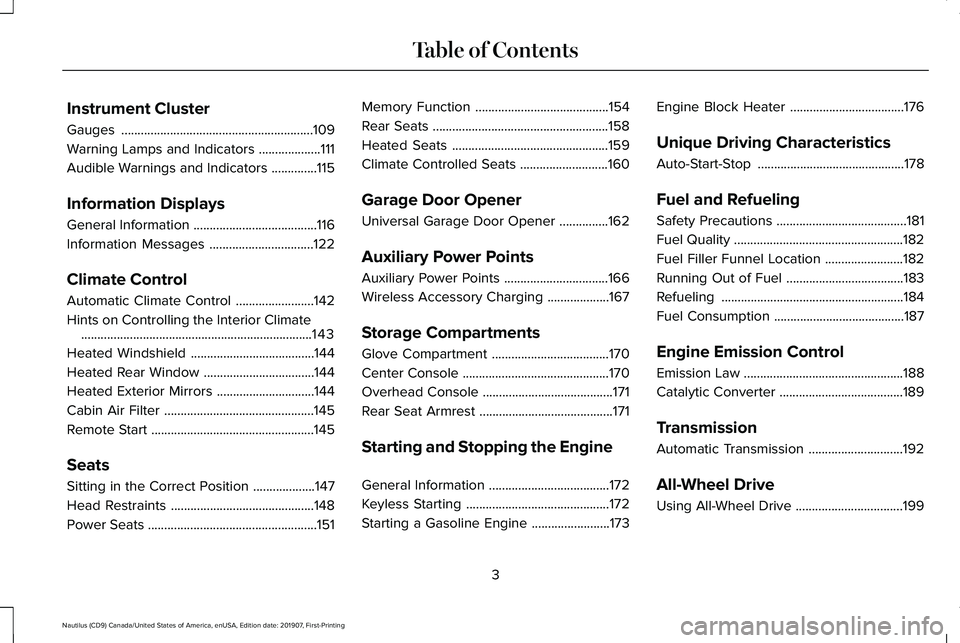
Instrument Cluster
Gauges
...........................................................109
Warning Lamps and Indicators ...................
111
Audible Warnings and Indicators ..............
115
Information Displays
General Information ......................................
116
Information Messages ................................
122
Climate Control
Automatic Climate Control ........................
142
Hints on Controlling the Interior Climate .......................................................................
143
Heated Windshield ......................................
144
Heated Rear Window ..................................
144
Heated Exterior Mirrors ..............................
144
Cabin Air Filter ..............................................
145
Remote Start ..................................................
145
Seats
Sitting in the Correct Position ...................
147
Head Restraints ............................................
148
Power Seats ....................................................
151Memory Function
.........................................
154
Rear Seats ......................................................
158
Heated Seats ................................................
159
Climate Controlled Seats ...........................
160
Garage Door Opener
Universal Garage Door Opener ...............
162
Auxiliary Power Points
Auxiliary Power Points ................................
166
Wireless Accessory Charging ...................
167
Storage Compartments
Glove Compartment ....................................
170
Center Console .............................................
170
Overhead Console ........................................
171
Rear Seat Armrest .........................................
171
Starting and Stopping the Engine
General Information .....................................
172
Keyless Starting ............................................
172
Starting a Gasoline Engine ........................
173Engine Block Heater
...................................
176
Unique Driving Characteristics
Auto-Start-Stop .............................................
178
Fuel and Refueling
Safety Precautions ........................................
181
Fuel Quality ....................................................
182
Fuel Filler Funnel Location ........................
182
Running Out of Fuel ....................................
183
Refueling ........................................................
184
Fuel Consumption ........................................
187
Engine Emission Control
Emission Law .................................................
188
Catalytic Converter ......................................
189
Transmission
Automatic Transmission .............................
192
All-Wheel Drive
Using All-Wheel Drive .................................
199
3
Nautilus (CD9) Canada/United States of America, enUSA, Edition date: 201907, First-Printing Table of Contents
Page 181 of 596
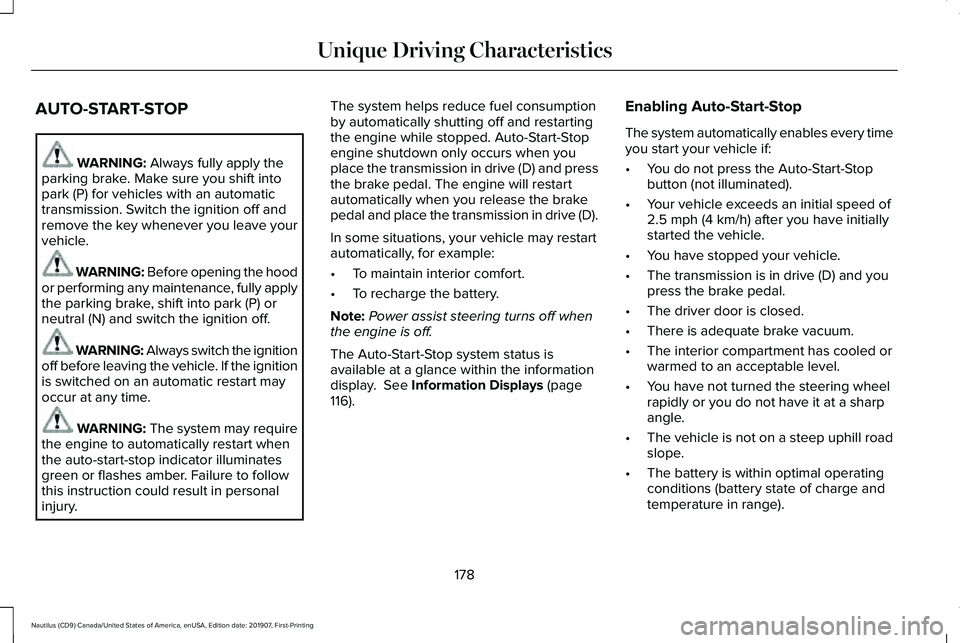
AUTO-START-STOP
WARNING: Always fully apply the
parking brake. Make sure you shift into
park (P) for vehicles with an automatic
transmission. Switch the ignition off and
remove the key whenever you leave your
vehicle. WARNING: Before opening the hood
or performing any maintenance, fully apply
the parking brake, shift into park (P) or
neutral (N) and switch the ignition off. WARNING: Always switch the ignition
off before leaving the vehicle. If the ignition
is switched on an automatic restart may
occur at any time. WARNING:
The system may require
the engine to automatically restart when
the auto-start-stop indicator illuminates
green or flashes amber. Failure to follow
this instruction could result in personal
injury. The system helps reduce fuel consumption
by automatically shutting off and restarting
the engine while stopped. Auto-Start-Stop
engine shutdown only occurs when you
place the transmission in drive (D) and press
the brake pedal. The engine will restart
automatically when you release the brake
pedal and place the transmission in drive (D).
In some situations, your vehicle may restart
automatically, for example:
•
To maintain interior comfort.
• To recharge the battery.
Note: Power assist steering turns off when
the engine is off.
The Auto-Start-Stop system status is
available at a glance within the information
display.
See Information Displays (page
116). Enabling Auto-Start-Stop
The system automatically enables every time
you start your vehicle if:
•
You do not press the Auto-Start-Stop
button (not illuminated).
• Your vehicle exceeds an initial speed of
2.5 mph (4 km/h)
after you have initially
started the vehicle.
• You have stopped your vehicle.
• The transmission is in drive (D) and you
press the brake pedal.
• The driver door is closed.
• There is adequate brake vacuum.
• The interior compartment has cooled or
warmed to an acceptable level.
• You have not turned the steering wheel
rapidly or you do not have it at a sharp
angle.
• The vehicle is not on a steep uphill road
slope.
• The battery is within optimal operating
conditions (battery state of charge and
temperature in range).
178
Nautilus (CD9) Canada/United States of America, enUSA, Edition date: 201907, First-Printing Unique Driving Characteristics
Page 190 of 596
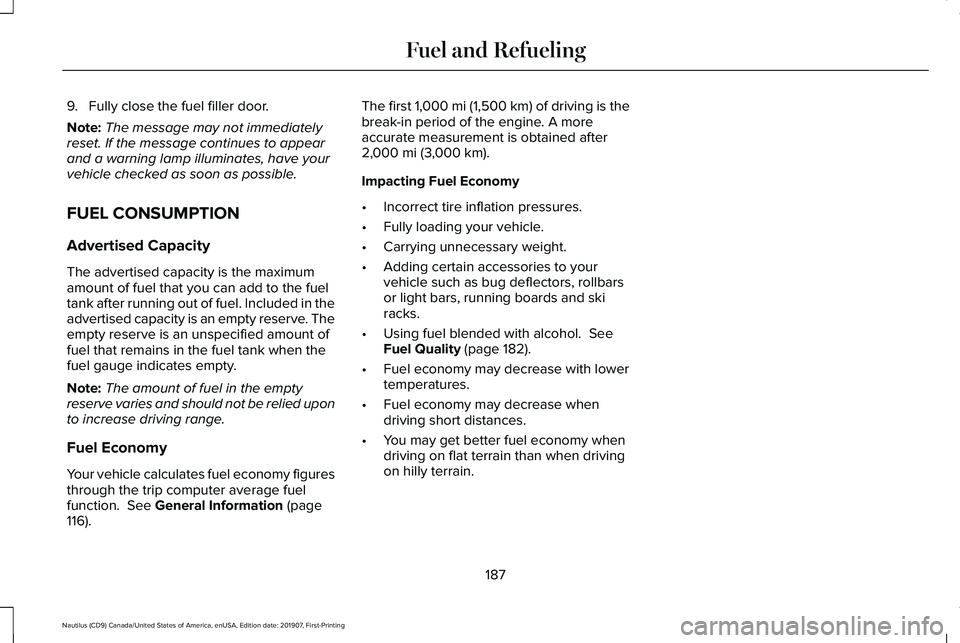
9. Fully close the fuel filler door.
Note:
The message may not immediately
reset. If the message continues to appear
and a warning lamp illuminates, have your
vehicle checked as soon as possible.
FUEL CONSUMPTION
Advertised Capacity
The advertised capacity is the maximum
amount of fuel that you can add to the fuel
tank after running out of fuel. Included in the
advertised capacity is an empty reserve. The
empty reserve is an unspecified amount of
fuel that remains in the fuel tank when the
fuel gauge indicates empty.
Note: The amount of fuel in the empty
reserve varies and should not be relied upon
to increase driving range.
Fuel Economy
Your vehicle calculates fuel economy figures
through the trip computer average fuel
function. See General Information (page
116). The first 1,000 mi (1,500 km) of driving is the
break-in period of the engine. A more
accurate measurement is obtained after
2,000 mi (3,000 km)
.
Impacting Fuel Economy
• Incorrect tire inflation pressures.
• Fully loading your vehicle.
• Carrying unnecessary weight.
• Adding certain accessories to your
vehicle such as bug deflectors, rollbars
or light bars, running boards and ski
racks.
• Using fuel blended with alcohol.
See
Fuel Quality (page 182).
• Fuel economy may decrease with lower
temperatures.
• Fuel economy may decrease when
driving short distances.
• You may get better fuel economy when
driving on flat terrain than when driving
on hilly terrain.
187
Nautilus (CD9) Canada/United States of America, enUSA, Edition date: 201907, First-Printing Fuel and Refueling
Page 191 of 596
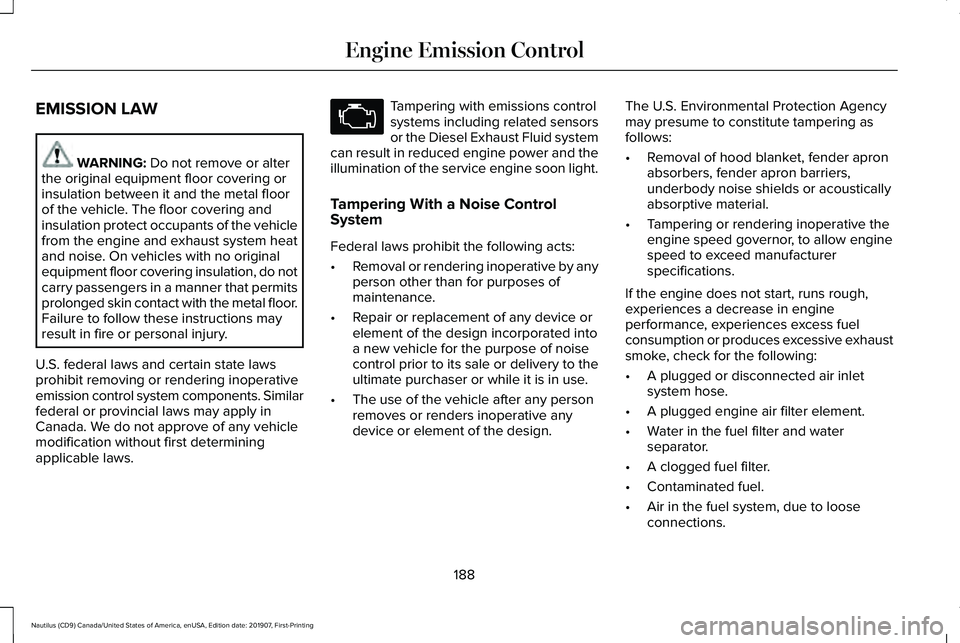
EMISSION LAW
WARNING: Do not remove or alter
the original equipment floor covering or
insulation between it and the metal floor
of the vehicle. The floor covering and
insulation protect occupants of the vehicle
from the engine and exhaust system heat
and noise. On vehicles with no original
equipment floor covering insulation, do not
carry passengers in a manner that permits
prolonged skin contact with the metal floor.
Failure to follow these instructions may
result in fire or personal injury.
U.S. federal laws and certain state laws
prohibit removing or rendering inoperative
emission control system components. Similar
federal or provincial laws may apply in
Canada. We do not approve of any vehicle
modification without first determining
applicable laws. Tampering with emissions control
systems including related sensors
or the Diesel Exhaust Fluid system
can result in reduced engine power and the
illumination of the service engine soon light.
Tampering With a Noise Control
System
Federal laws prohibit the following acts:
• Removal or rendering inoperative by any
person other than for purposes of
maintenance.
• Repair or replacement of any device or
element of the design incorporated into
a new vehicle for the purpose of noise
control prior to its sale or delivery to the
ultimate purchaser or while it is in use.
• The use of the vehicle after any person
removes or renders inoperative any
device or element of the design. The U.S. Environmental Protection Agency
may presume to constitute tampering as
follows:
•
Removal of hood blanket, fender apron
absorbers, fender apron barriers,
underbody noise shields or acoustically
absorptive material.
• Tampering or rendering inoperative the
engine speed governor, to allow engine
speed to exceed manufacturer
specifications.
If the engine does not start, runs rough,
experiences a decrease in engine
performance, experiences excess fuel
consumption or produces excessive exhaust
smoke, check for the following:
• A plugged or disconnected air inlet
system hose.
• A plugged engine air filter element.
• Water in the fuel filter and water
separator.
• A clogged fuel filter.
• Contaminated fuel.
• Air in the fuel system, due to loose
connections.
188
Nautilus (CD9) Canada/United States of America, enUSA, Edition date: 201907, First-Printing Engine Emission Control
Page 271 of 596
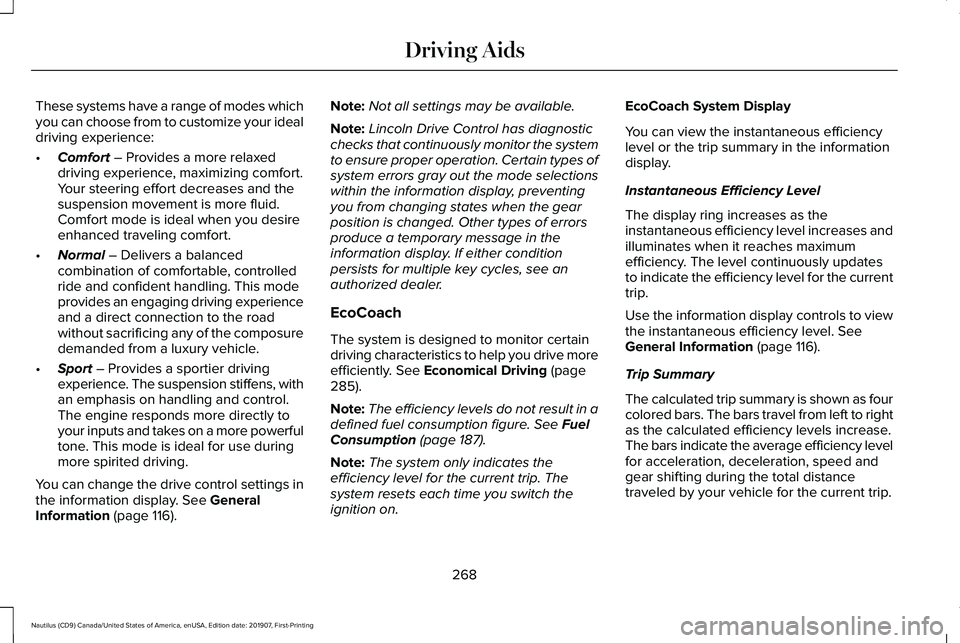
These systems have a range of modes which
you can choose from to customize your ideal
driving experience:
•
Comfort – Provides a more relaxed
driving experience, maximizing comfort.
Your steering effort decreases and the
suspension movement is more fluid.
Comfort mode is ideal when you desire
enhanced traveling comfort.
• Normal
– Delivers a balanced
combination of comfortable, controlled
ride and confident handling. This mode
provides an engaging driving experience
and a direct connection to the road
without sacrificing any of the composure
demanded from a luxury vehicle.
• Sport
– Provides a sportier driving
experience. The suspension stiffens, with
an emphasis on handling and control.
The engine responds more directly to
your inputs and takes on a more powerful
tone. This mode is ideal for use during
more spirited driving.
You can change the drive control settings in
the information display.
See General
Information (page 116). Note:
Not all settings may be available.
Note: Lincoln Drive Control has diagnostic
checks that continuously monitor the system
to ensure proper operation. Certain types of
system errors gray out the mode selections
within the information display, preventing
you from changing states when the gear
position is changed. Other types of errors
produce a temporary message in the
information display. If either condition
persists for multiple key cycles, see an
authorized dealer.
EcoCoach
The system is designed to monitor certain
driving characteristics to help you drive more
efficiently.
See Economical Driving (page
285).
Note: The efficiency levels do not result in a
defined fuel consumption figure.
See Fuel
Consumption (page 187).
Note: The system only indicates the
efficiency level for the current trip. The
system resets each time you switch the
ignition on. EcoCoach System Display
You can view the instantaneous efficiency
level or the trip summary in the information
display.
Instantaneous Efficiency Level
The display ring increases as the
instantaneous efficiency level increases and
illuminates when it reaches maximum
efficiency. The level continuously updates
to indicate the efficiency level for the current
trip.
Use the information display controls to view
the instantaneous efficiency level.
See
General Information (page 116).
Trip Summary
The calculated trip summary is shown as four
colored bars. The bars travel from left to right
as the calculated efficiency levels increase.
The bars indicate the average efficiency level
for acceleration, deceleration, speed and
gear shifting during the total distance
traveled by your vehicle for the current trip.
268
Nautilus (CD9) Canada/United States of America, enUSA, Edition date: 201907, First-Printing Driving Aids
Page 275 of 596
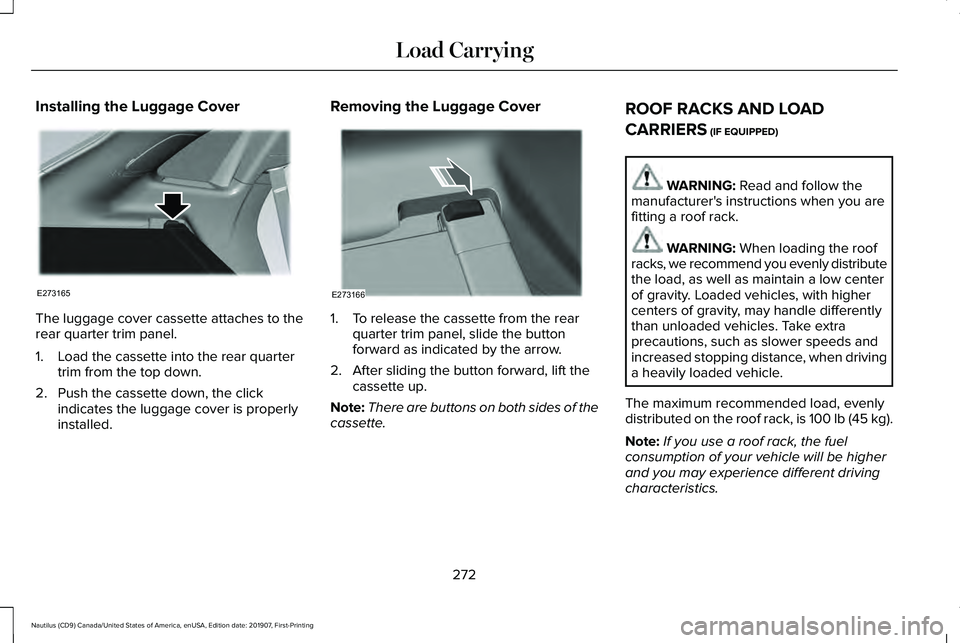
Installing the Luggage Cover
The luggage cover cassette attaches to the
rear quarter trim panel.
1. Load the cassette into the rear quarter
trim from the top down.
2. Push the cassette down, the click indicates the luggage cover is properly
installed. Removing the Luggage Cover
1. To release the cassette from the rear
quarter trim panel, slide the button
forward as indicated by the arrow.
2. After sliding the button forward, lift the cassette up.
Note: There are buttons on both sides of the
cassette. ROOF RACKS AND LOAD
CARRIERS (IF EQUIPPED) WARNING:
Read and follow the
manufacturer's instructions when you are
fitting a roof rack. WARNING:
When loading the roof
racks, we recommend you evenly distribute
the load, as well as maintain a low center
of gravity. Loaded vehicles, with higher
centers of gravity, may handle differently
than unloaded vehicles. Take extra
precautions, such as slower speeds and
increased stopping distance, when driving
a heavily loaded vehicle.
The maximum recommended load, evenly
distributed on the roof rack, is 100 lb (45 kg).
Note: If you use a roof rack, the fuel
consumption of your vehicle will be higher
and you may experience different driving
characteristics.
272
Nautilus (CD9) Canada/United States of America, enUSA, Edition date: 201907, First-Printing Load CarryingE273165 E273166
Page 587 of 596
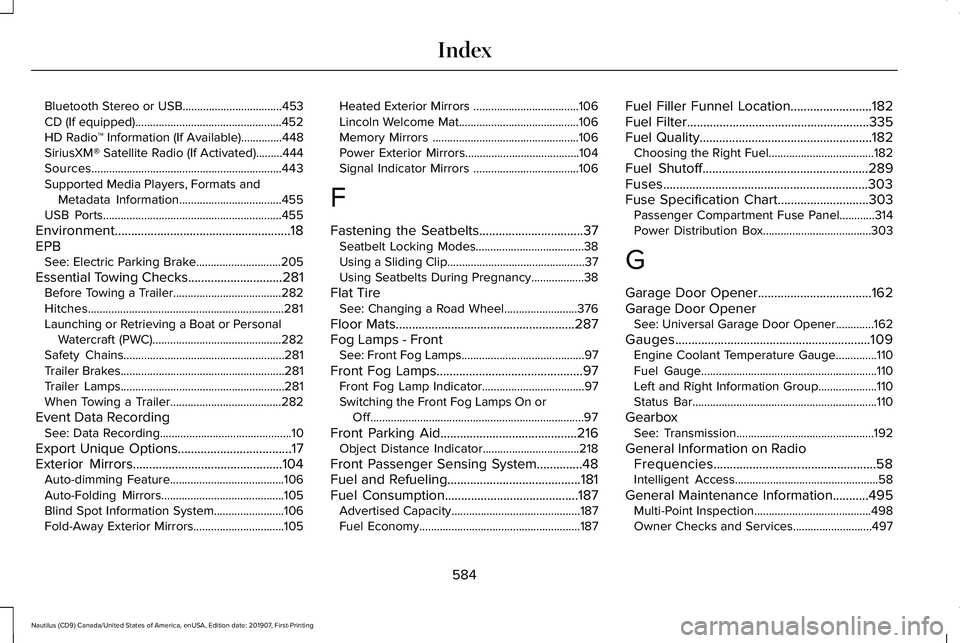
Bluetooth Stereo or USB..................................453
CD (If equipped)..................................................452
HD Radio
™ Information (If Available)..............448
SiriusXM® Satellite Radio (If Activated).........444
Sources.................................................................443
Supported Media Players, Formats and Metadata Information...................................
455
USB Ports.............................................................455
Environment......................................................18
EPB See: Electric Parking Brake.............................205
Essential Towing Checks.............................281 Before Towing a Trailer.....................................282
Hitches...................................................................281
Launching or Retrieving a Boat or Personal
Watercraft (PWC)............................................282
Safety Chains.......................................................281
Trailer Brakes........................................................281
Trailer Lamps........................................................281
When Towing a Trailer......................................282
Event Data Recording See: Data Recording.............................................10
Export Unique Options...................................17
Exterior Mirrors
..............................................104
Auto-dimming Feature.......................................106
Auto-Folding Mirrors..........................................105
Blind Spot Information System........................106
Fold-Away Exterior Mirrors...............................105 Heated Exterior Mirrors ....................................106
Lincoln Welcome Mat.........................................106
Memory Mirrors ..................................................106
Power Exterior Mirrors.......................................104
Signal Indicator Mirrors ....................................106
F
Fastening the Seatbelts................................37 Seatbelt Locking Modes.....................................38
Using a Sliding Clip...............................................37
Using Seatbelts During Pregnancy..................38
Flat Tire See: Changing a Road Wheel.........................376
Floor Mats
.......................................................287
Fog Lamps - Front See: Front Fog Lamps..........................................97
Front Fog Lamps.............................................97 Front Fog Lamp Indicator...................................97
Switching the Front Fog Lamps On or
Off........................................................................\
.97
Front Parking Aid..........................................216 Object Distance Indicator.................................218
Front Passenger Sensing System..............48
Fuel and Refueling
.........................................181
Fuel Consumption.........................................187
Advertised Capacity............................................187
Fuel Economy.......................................................187 Fuel Filler Funnel Location.........................182
Fuel Filter
........................................................335
Fuel Quality.....................................................182
Choosing the Right Fuel....................................182
Fuel Shutoff
...................................................289
Fuses...............................................................303
Fuse Specification Chart
............................303
Passenger Compartment Fuse Panel............314
Power Distribution Box.....................................303
G
Garage Door Opener...................................162
Garage Door Opener See: Universal Garage Door Opener.............162
Gauges............................................................109 Engine Coolant Temperature Gauge..............
110
Fuel Gauge............................................................110
Left and Right Information Group....................110
Status Bar...............................................................110
Gearbox See: Transmission...............................................192
General Information on Radio Frequencies..................................................58
Intelligent Access.................................................58
General Maintenance Information...........495 Multi-Point Inspection........................................498
Owner Checks and Services...........................497
584
Nautilus (CD9) Canada/United States of America, enUSA, Edition date: 201907, First-Printing Index